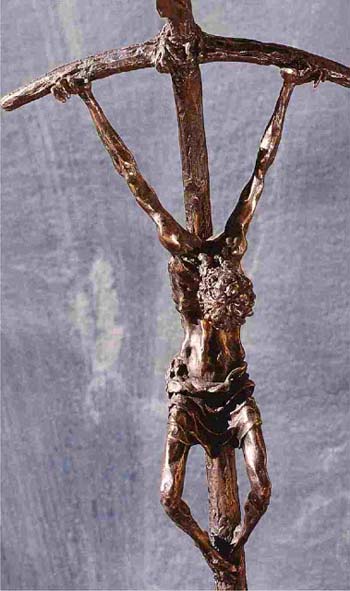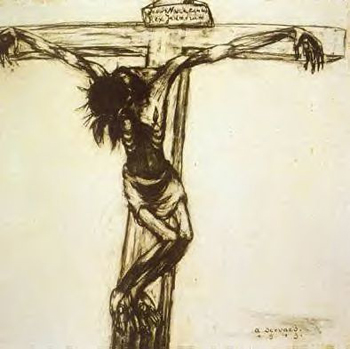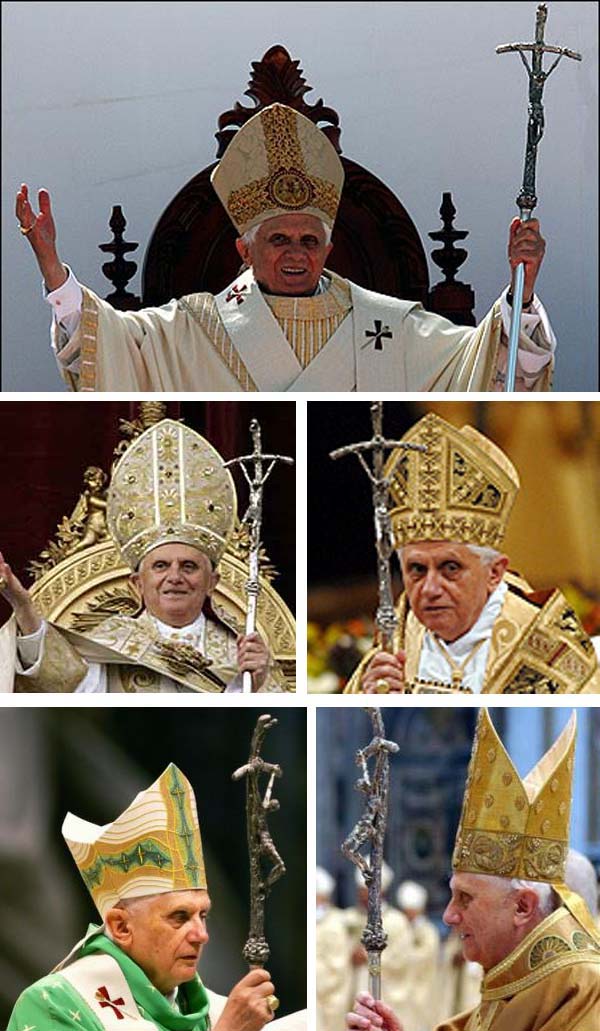Art & Architecture
 |
 |
 |
 |
 |
 |
 |
Behind the Contorted Papal Cross

The Scorzelli papal cross commissioned by Paul VI in 1963

Crucifixion - From the Via Crucis by Servaes - 1919
These drawings are a clear example of the new school of "Expressionism" applied to sacred art. Servaes was one of the artists of the Laethem School living together in community outside of Ghent in Laethem-Saint-Martin, Flanders. The works of the Laethem School and the Expressionalism it adopted were characterized by pessimism, mystical symbols, a distorted stylization and search for “exotic” primitivism in nature.

The broken cross became a symbol of the Vatican II papacy
Rebelling against the decorous and delicate forms of French Impressionism, the Expressionists sought to discover a supposed tragic inner reality of which the artist is the interpreter. Albert Servaes was guided spiritually by Carmelite mentor Fr. Jerome, who initiated him in an occult “mysticism of suffering.” It was under this influence that he sketched the Stations of the Cross for the Luithagen chapel soon after WWI.
Servaes’ style became so macabre in his dark Expressionalism that this Way of Cross (1919) drew upon him the condemnation of the Church. Indeed, the condemnation of the Via Crucis of Servaes came straight from the Holy Office, with the direct approval of Pope Benedict XV. This Decretum stands out because it is not just a condemnation of one specific work of Albert Servaes, but the banning of an entire school of art as being opposed to Faith and Tradition.
Now, as the reader can see, the Scorzelli papal cross - commissioned by a Pope a half century after that condemnation - is nothing but the revival of that condemned Expressionism. It is, as a commentator who inspired this article noted, “the revenge of Servaes proclaimed to the world in 1965.”
In fact, not only was this condemnation ignored after Vatican II, but the crozier inspired by Servaes became a symbol of the pontificates of Paul VI, John Paul I, John Paul II & Benedict XVI. Francis I was quick to assume this horrific insignia in the first days of his papacy.
Anyone who looks closely at this gruesome crucifix, with the Christ whose hands look like claws, his legs rudely sprawled open, and his hidden downcast head, can see something devilish in it. It is no wonder the Church solemnly condemned the artist who inspired it. Now, we witness this sad sign of the times: That same cross has been assumed as a symbol of the conciliar Popes in open scorn of the previous condemnation by Benedict XV.
Since the papacy of John Paul II, this crucifix has been placed on every papal rosary that is given out. Thus, many unknowing Catholics have become accustomed to this monstrosity, believing it to be acceptable just because it has been approved by the conciliar Popes.
In closing, I would like to point out the inaccuracy of some reports made by conservative and traditionalist commentators which assert that Benedict XVI supposedly retired this “broken cross,” Doing so they imply that he did not approve it.
As you can see in the collection of pictures below, Pope Ratzinger definitively did not retire the Scorzelli crucifix, but used it often, thus showing his acceptance and approval of it. During his entire pontificate, it was also on all the papal rosaries that he handed out as gifts.
It is an example of the continuity practiced by Benedict XVI, a continuity that is not in an authentic tradition – which condemned this art style – but rather a continuity in error, occult symbols and promotion of modern art. Here we have a good example of where the openness to the modern world preached by Vatican II is leading us: a devilish art invading the Papacy.

Despite denials of conservatives, Benedict XVI approved the Scorzelli cross and used it often

Posted May 8, 2013
______________________
______________________



